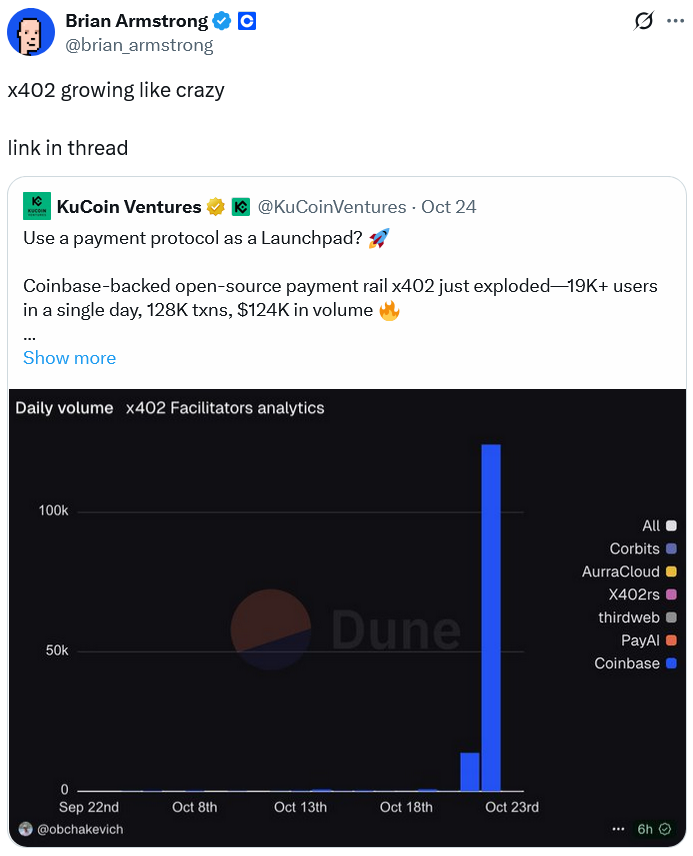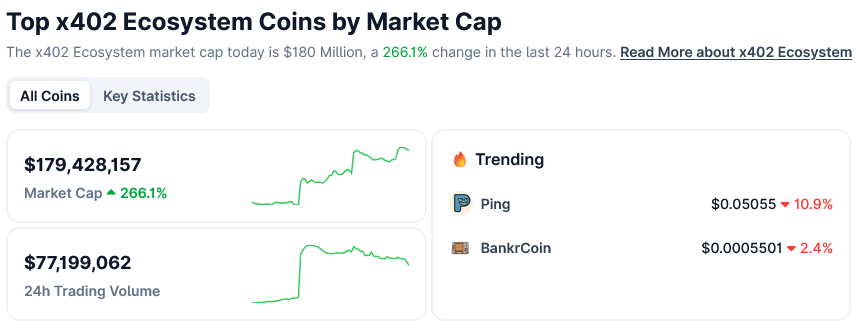The x402 protocol, developed by Coinbase, enables AI agents to conduct autonomous transactions using stablecoins over the internet, with transaction activity surging over 10,000% in the past month to nearly 500,000 transactions.
-
x402 revives HTTP 402 for seamless, direct payments without credit cards.
-
It allows AI and humans to pay instantly via stablecoins during web interactions.
-
Transaction volume hit a record $332,000 on Thursday, per Dune Analytics data.
Discover how Coinbase’s x402 protocol is revolutionizing AI payments with a 10,000% transaction surge. Explore its impact on crypto and autonomous finance today.
What is the x402 Protocol?
The x402 protocol is an innovative online payments system introduced by Coinbase in May that allows AI agents and users to transact seamlessly with stablecoins directly over the internet. By resurrecting the HTTP 402 “Payment Required” status code from early internet protocols, x402 addresses foundational limitations in web payments, enabling instant, verified transactions without intermediaries like credit cards. This protocol facilitates atomic payments and programmable policies, making it ideal for autonomous AI operations.

Source: Brian Armstrong
Coinbase’s x402 protocol, which enables AI agents to transact autonomously over the internet, has seen a 10,000% rise in transaction activity over a month. An online payments protocol introduced by Coinbase in May that enables AI agents to transact in stablecoins over the internet has seen more than a 10,000% increase in transaction activity over the last month. At the time, Coinbase said x402 fixes “the internet’s first mistake” by resurrecting the Internet Communication Protocol’s Hypertext Transfer Protocol 402 — or HTTP 402 — to create a seamless payment system native to the internet.
It lets AI — and humans — pay directly while using a website or app: they request something, receive a HTTP 402 “Payment Required” prompt, and then send a signed stablecoin payment, which x402 then verifies automatically. No credit cards required. There were nearly 500,000 x402 transactions between Oct. 14 and 20, marking a 10,780% rise in comparison to levels seen four weeks earlier, according to Dune Analytics data. Transaction activity went even higher on Friday, with other Dune Analytics data showing a record 239,505 transactions were made, while on Thursday, a record $332,000 in transaction volume was posted.
It comes as tech-focused venture capital firm a16z’s crypto arm mentioned agentic AI in its 2025 State of Crypto report earlier this week — where it anticipated that autonomous transactions could reach $30 trillion by 2030. Without the need for human intervention in managing API calls, storage, and computation, agentic AIs could enable everything from self-driving taxis covering their own costs with stablecoins to apps automatically using stablecoins to store data permanently, Coinbase development team members Kevin Leffew and Lincoln Murr said in August.
In a limited manner, AI agents are already trading crypto by analyzing market data, executing buy or sell orders, and optimizing portfolios in real time without human intervention. This growing adoption underscores the protocol’s potential to integrate AI with blockchain for efficient, trustless financial interactions.
How Has x402 Transaction Activity Surged So Dramatically?
The surge in x402 transaction activity can be attributed to its seamless integration with stablecoins and Ethereum’s robust infrastructure, allowing for rapid, low-friction payments. Dune Analytics reports highlight a 10,780% increase, from modest beginnings to nearly 500,000 transactions in a single week, driven by developer adoption and AI experimentation. On peak days, volumes exceeded $332,000, reflecting real-world use cases like automated content access and micro-payments for AI services.
Experts from a16z’s crypto division, in their 2025 State of Crypto report, project that agentic AI transactions could scale to $30 trillion by 2030, emphasizing x402’s role in enabling this growth. Coinbase developers Kevin Leffew and Lincoln Murr have noted that the protocol eliminates traditional payment hurdles, such as chargebacks and slow settlements, by leveraging blockchain’s atomicity. This efficiency is particularly evident in AI applications, where agents handle tasks independently, from data storage to real-time trading.
Supporting data from Dune Analytics further illustrates this momentum: transaction counts jumped to 239,505 on a single Friday, showcasing exponential interest. As AI models become more autonomous, x402 positions itself as a foundational layer for internet-native payments, reducing reliance on centralized processors and enhancing security through cryptographic verification.
CoinGecko Lists x402 Tokens as a New Category
Developers are now leveraging x402’s design to launch tokens directly — fueling a wave of x402-powered memecoin launches, as noted by KuCoin Ventures on social media platforms. The rise prompted CoinGecko to track x402 tokens as a new ecosystem, which has boomed into a near $180 million market, up 266% over the last 24 hours.

Source: CoinGecko
Ethereum is the Best Fit for HTTP 402
Leffew and Murr said Ethereum’s trustless settlement layer makes it the ideal blockchain for HTTP 402 implementation, noting that it makes invoices and dispute chargebacks far more efficient than traditional processes. “They need atomic payments, programmable policies, and composable wallets. Ethereum and stablecoins give them exactly that.” This synergy allows for programmable money that aligns perfectly with AI’s need for instant, verifiable exchanges, positioning Ethereum as the backbone for future x402 expansions.
The protocol’s compatibility with Ethereum extends to its support for stablecoins, which provide price stability essential for AI-driven economies. By enabling direct web payments, x402 reduces latency and costs associated with legacy systems, fostering innovation in decentralized applications. As adoption grows, Ethereum’s scalability solutions, like layer-2 networks, will further amplify x402’s efficiency, according to insights from blockchain analysts.
Frequently Asked Questions
What Makes the x402 Protocol Ideal for AI Agents?
The x402 protocol is designed for AI agents by enabling autonomous, stablecoin-based transactions without human oversight, using HTTP 402 for instant payment prompts and verification. This eliminates barriers like credit card processing, allowing AI to handle tasks such as trading or data purchases efficiently, as evidenced by the recent 10,000% transaction surge reported by Dune Analytics.
How Does x402 Integrate with Existing Web Technologies?
x402 integrates seamlessly with web technologies by reviving the HTTP 402 status code, prompting payments during user or AI interactions on websites and apps. It verifies signed stablecoin transactions automatically on the blockchain, ensuring security and speed, which makes it a natural extension for modern internet applications, sounding straightforward when queried via voice assistants.
Key Takeaways
- Exponential Growth: x402 transactions rose 10,780% to nearly 500,000 in a week, per Dune Analytics, signaling strong AI payment adoption.
- Ethereum Compatibility: The protocol thrives on Ethereum’s trustless layer, offering atomic payments and programmable policies for efficient settlements.
- Future Potential: With projections of $30 trillion in autonomous transactions by 2030 from a16z, explore x402 for innovative AI-crypto integrations today.
Conclusion
In summary, Coinbase’s x402 protocol marks a pivotal advancement in autonomous payments, with its 10,000% transaction surge highlighting the demand for seamless AI-stablecoin interactions. By leveraging HTTP 402 and Ethereum’s infrastructure, it addresses longstanding internet payment inefficiencies, paving the way for agentic AI economies. As developments continue, staying informed on x402 transaction activity will be crucial for navigating the evolving landscape of crypto and AI—consider integrating these tools into your strategies for forward-thinking financial operations.
